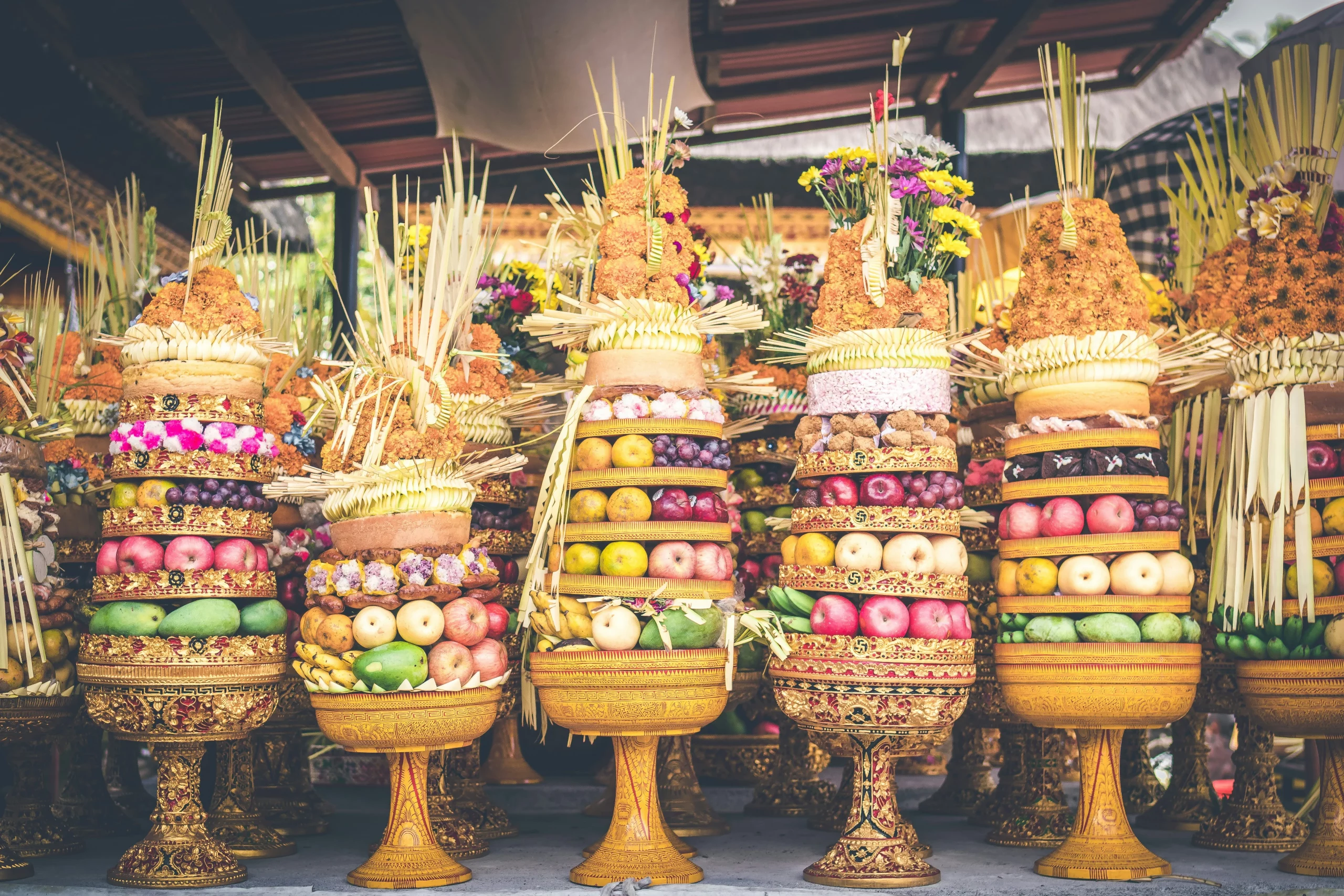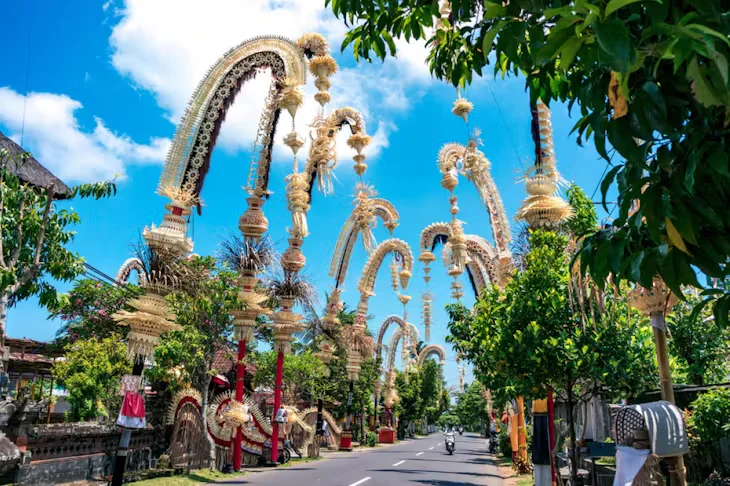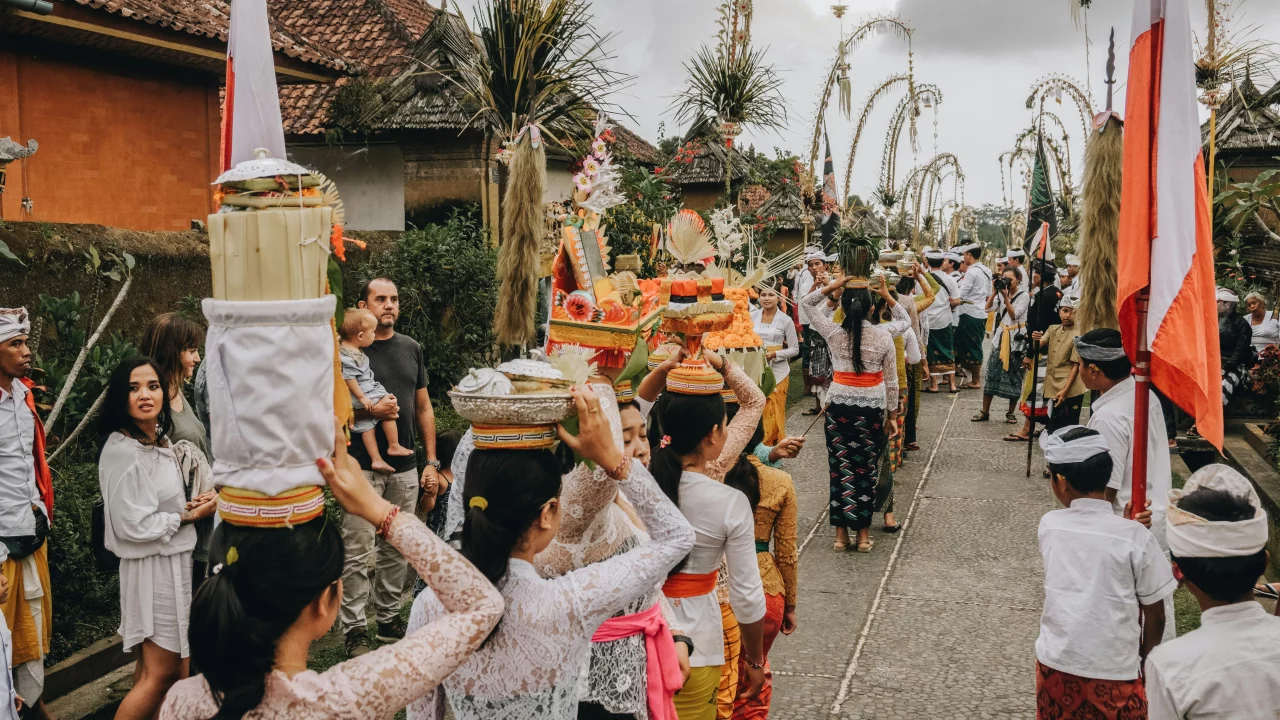In the heart of Bali, amidst sun-drenched beaches and verdant rice paddies, lies a festival brimming with vibrant colours and boundless joy: Galungan and Kuningan day. This ten-day celebration transcends mere festivities—it commemorates the triumph of good over evil, dharma prevailing against adharma.
Get ready to witness intricate rituals, towering bamboo offerings that pierce the sky, breath in the fragrant incense, and partake in a profound sense of community connection. Join us as we explore the traditions and delve into the meaning behind this festive occasion.
What Is Galungan Day?
According to the Balinese calendar, every 210 days, or twice a year, Bali comes alive in a vibrant celebration known as Galungan day—the pinnacle of Balinese Hindu ceremonies that commemorate the triumph of dharma over adharma, or the victory of good over evil.
Galungan Day always falls on a Wednesday, which is believed to be Buddha Day in the Balinese calendar. This alignment adds an extra layer of reverence to the festivities, as families and communities come together to honour this significant occasion over ten days.
During this ten-day ceremony, Bali experiences a sacred transformation. Temples and homes resound with prayers, and meticulous preparations for intricate offerings take place. Among these offerings, the penjor takes centre stage—a captivating display of colourful tall bamboo poles adorned with intricate decorations, soaring skyward and gracing every street.
These penjors serve as profound expressions of gratitude towards ancestors and Sang Hyang Widhi Wasa, the supreme deity in Balinese Hinduism. Balinese people believe that during Galungan Day, these revered entities descend to Earth, joining the community in the celebrations. The mesmerising sight of penjors, along with their symbolic offerings, creates a visual symphony of devotion and thanksgiving that permeates every corner of the island during this auspicious occasion.
However, Galungan Day is more than just a festive event. It’s a time for families to reunite, communities to strengthen bonds, and individuals to engage in introspection as well as connect with their inner dharma.
What Is Kuningan Day?
As the ten-day Galungan ceremony draws to a close, Kuningan Day begins. This ceremony marks the departure of ancestor spirits back to their celestial realm. The name ‘Kuningan’ is derived from the Balinese word kuning, which means yellow. On this day, Balinese community presents special offerings, including yellow rice, fruits, and flowers, meticulously arranged in small coconut leaf bowls. These offerings symbolise gratitude for the blessings of happiness, health, and prosperity. It is believed that the ancestors ascend at midday, so all Kuningan ceremonies and offerings must be completed before noon.
Galungan Day Preparations


Prior to the grand celebration of Galungan Day, Balinese people engage in three days of preparations, involving various rituals that must be completed.
1. Penyekeban Day
Penyekeban Day, also known as “the day to cover,” initiates the preparations for Galungan Day. This begins three days before the main event, typically on a Sunday. During this time, Balinese Hindus cover young green bananas and other fruits in large clay pots, expediting the ripening process for these items used in the upcoming offerings.
2. Penyajaan Day
On Monday, which is two days before Galungan Day, the Balinese observe Penyajaan Day. On this day, the Balinese engage in self-reflection while simultaneously preparing traditional cakes known as jaja. These colourful rice dough cakes are fried and used in offerings, or enjoyed on Galungan Day. Additionally, during this period, Balinese also craft various ceremonial facilities, including decorations made from coconut leaf and bamboo.
3. Penampahan Day
Penampahan Day, known as the slaughtering day, is typically observed on Tuesday, just one day before Galungan Day. On this occasion, the Balinese engage in the ritualistic slaughter of animals, including pigs, chickens, and ducks (excluding cows). The processed meat is then used to create various dishes such as satay, lawar, urutan, pepes, and more. This communal slaughter is often done in collaboration with neighbours, relatives, or friends. Following the completion of the slaughter, a cleansing ritual for the yard is performed, and the penjor is installed in the yard.
Galungan Ceremony


After three days of meticulous preparation, the grand celebration of Galungan Day unfolds and lasts for a remarkable ten days. Following the Galungan festivities, there are several subsequent celebrations that must be observed.
1. Galungan Day
On Galungan Day, everything prepared beforehand is offered during prayer ceremonies. These sacred rituals take place in various locations, including homes and temples, with vibrant and colourful offerings presented to the deities.
2. Umanis Galungan Day
The day following Galungan Day, Balinese communities celebrate Umanis Galungan Day by visiting their relatives. A special highlight of this day is the ‘Ngelawang,’ a mesmerising dance of the mythical Barong performed in every village. The purpose of this ritual is to expel evil and negativity. The Barong, a divine protector, visits homes, restoring the balance between good and evil. Residents present canang sari, the Balinese offerings, and sesari or cash to the Barong, receiving a piece of its fur as a keepsake in return.
3. Kuningan Day
Following the ten-day Galungan ceremony, Kuningan Day unfolds, marking the conclusion of the Galungan celebrations. On this day, Balinese people meticulously prepare special offerings, which include yellow rice, fruits, and flowers arranged in coconut leaf bowls. These offerings symbolise expressions of gratitude for the prosperity, protection, and safety bestowed by Ida Sang Hyang Widhi Wasa. Additionally, it is crucial to have these offerings ready before noon, as it is believed that ancestor spirits depart from Earth after midday.
4. Pegat Wakan Day
Pegat Wakan Day is the concluding ceremony of the Galungan and Kuningan celebrations. During this time, Balinese Hindus pray and remove the penjors, the distinctive bamboo poles adorned with colourful coconut leaves that have graced the streets during the festivities. Pegat Wakan falls on a Wednesday, one month after Galungan.
Conclusion
For the Balinese people, Galungan and Kuningan are more than just religious ceremonies; they represent a profound connection to their culture and spirituality. The colourful rituals and vibrant traditions offer a glimpse into the rich tapestry of Balinese Hinduism, making it a unique and enchanting experience for anyone living in Bali or visiting this beautiful island. Witnessing these ceremonies firsthand can be a truly enriching and memorable experience, providing deeper insights into the Balinese way of life.








One comment
Owehems
November 22, 2024 at 8:09 am
nelfinavir increases levels of oxycodone by affecting hepatic intestinal enzyme CYP3A4 metabolism priligy for pe